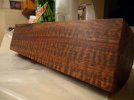Kelly's cross grain use of the snakewood is interesting. It certainly saves the high waste of the sapwood areas.
The premium area is the highly figured "snake-skin" pattern located toward the core.
After the first cut ( half log), carefully consider the location and type of the pattern before cutting the log farther. Also, think about the handle types you will be making. I slab one quarter into thinner scales, one into thicker scales, and the other two into handle blocks.
When you quarter-saw the log, it will yield slabs like Kelly showed, having stripes toward the outer side, and snake pattern toward the inside. On the wider slabs, I rip saw the two areas apart. The stripped and lesser figure areas I use for tool handles and turning projects. The highly snake figured slabs I use for high end handles. Expect about 25% of the slabs will be primo, 25% good, and the rest used for lower end knives or other projects.
I have never had snakewood stabilized. But know that some folks do. Check with Mike ,at WSSI, on his opinion.
After the newly acquired log is quarter-sawn, I seal the ends with CA. Then I let it sit on the wood shelves for a long time - 6 months minimum, a year or more is better. It needs time to stress relieve. Expect cracks and checks...that is the nature of snakewood.
With snakewood, cyanoacrylic glue is you friend. When ready to use the slabs, flood the surface of the slabs with super thin CA and let it cure for a day or two. As you work the wood, flood any cracks that show up with CA and let it cure before continuing. I do not like accelerator for such uses. It can create stress, heat, and also can cause a funny hazy look to the wood.
Sanding and finishing snakewood is best done as much by hand as possible. Use sharp belts for any power sanding, bi-metal or carbide blades when sawing, and avoid any heat buildup. Be very cautious if power buffing, as cracks can form in the surface while and after buffing ( the same as with ebony).
When the handle is done with all shaping, flood it with CA again, let it cure for a couple days, sand it down to the surface, and finish the grits up to 8000. It will shine like glass. Even now, the knife is not done. You will need to set it aside for a month or two to allow any new (usually tiny) cracks and checks to show up. If any do, seal them with super thin CA, and hand finish that spot again.
Snakewood is not for those in a hurry, or those with low patience, or short fuses. It will reward you with a stunning handle if you take your time and work with the wood, not against it.
Stacy
Afterthought -
Never plain-saw ( flat saw) a snakewood log. Plain-sawn snakewood looks different from one side ( looking toward the center) than the other ( looking toward the outside of the log) The wood may look very figured,and appear even in color as a block - but when you are done with the knife, it will display different colors, pattern, and chatoyancy on each side of the handle. Generally one side will be light and the other dark. A properly sawn snakewood block or scale block should look the same from opposite sides. When the flat sawn log is used for scales, this is not such a problem ( as you only see one side of a scale), but, if using scales, carefully examine the surface and pattern to assure that you are putting matching surfaces showing, or the same problem will arise.
Stacy











